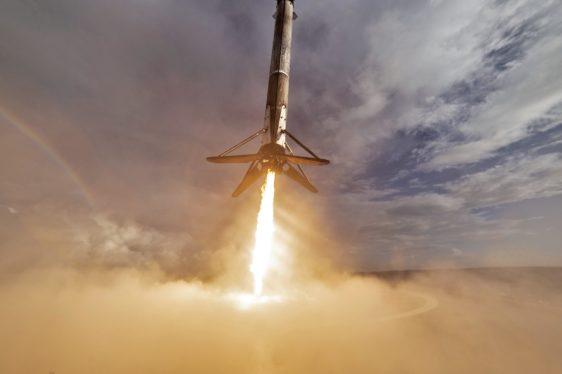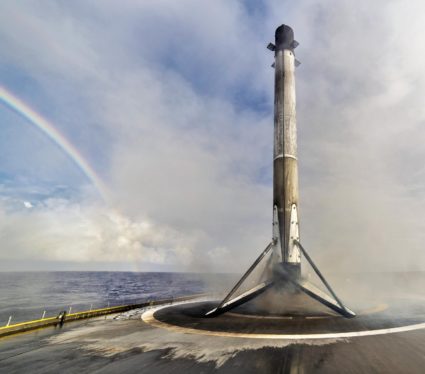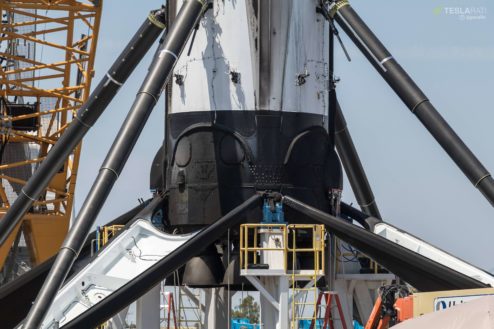
All major aspects of SpaceX’s most recent Falcon 9 Block 5 booster recovery have been documented from start to finish, offering a solid glimpse into the work that actually goes into getting a rocket booster from the deck of a SpaceX drone ship to one of the company’s many hangars for inspections, repairs, and refurbishment.
Filmed by USLaunchReport, a SpaceX-focused nonprofit staffed by U.S. veterans, the group’s coverage of a variety of SpaceX events may not always offer the highest production quality, but the sheer tenacity and patience of those behind the cameras allow them to capture unique and interesting events that almost nobody else is keen to wait around for.
SpaceX Falcon 9 Block 5 booster sails into port aboard droneship OCISLY after successful reusehttps://t.co/zQtidwzvhp
— TESLARATI (@Teslarati) November 21, 2018
Over the course of four videos focused on SpaceX’s recovery of Falcon 9 Block 5 booster B1047, USLaunchReport offered good views of four major events that occur during all rocket recovery operations: the drone ship’s return to port, Falcon 9’s move from ship to shore, the booster’s landing leg removal (or retraction), and the booster’s transfer from a vertical to horizontal orientation and transport by road back to a SpaceX hangar.
Of Course I Still Love You arrives at Port Canaveral
As with all of Falcon 9’s drone ship landings, B1047 came to a rest on a station-keeping OCISLY several hundred miles east of the Florida coast, coincidentally landing directly in front of a giant rainbow cued by rain clouds, both visible in the background. In theory, B1047’s second landing should by no means be the rocket’s last: if Falcon 9 Block 5’s first stage upgrades are as successful as they hoped to be, the rocket could well see a productive life of 100 launches or more between now and BFR’s complete takeover.
For at least the next 5-10 years, however, SpaceX followers will continue to be treated to spectacular Falcon 9 and Falcon Heavy booster recoveries, particularly the moment when each booster sails through the narrow mouth of Port Canaveral or Port of Los Angeles, offering spectators almost unbeatable views of just-landed SpaceX rockets.
SpaceX – Last Ten Miles To Dock.
Next Men at Work. B1047.2 https://t.co/6C4YDhUpJ6— Mike Wagner (@USLaunchReport) November 21, 2018
Falcon 9’s lift from ship to shore
Soon after the drone ship docks in port, SpaceX recovery technicians install a brace and lifting jig that attaches to Falcon 9’s booster interstage, using the same mechanisms that connect the first stage to the second stage prior to stage separation. The interstage’s mechanical actuators are strong enough to support – at a minimum – the entire weight of an empty Falcon 9 booster, allowing SpaceX to simply attach the jig and lift Falcon 9 off of the drone ship with any number of large but commercially available cranes.
Rather than directly lowering the rocket and allowing it to rest directly on its landing legs again, SpaceX technicians make use of a custom-built stand that acts as a sort of barebones, static replica of the mounts Falcon 9s are attached to at SpaceX launch pads. Structurally optimized to allow Falcon 9 and Heavy to be held down on the launch pad while operating at full thrust, a series of four solid-metal attachment points interface with those hold-down clamps, attach to Falcon 9’s four landing legs, and offer an easily accessible and structurally sound method of sitting a booster upright (sans legs) and maneuvering it during recovery operations.
B1048 nears the end of its recovery cycle, August 2nd. (Pauline Acalin)
” data-medium-file=”https://www.teslarati.com/wp-content/uploads/2018/08/F9-B1048-lift-Merlins-octaweb-080218-Pauline-Acalin-6c-300×200.jpg” data-large-file=”https://www.teslarati.com/wp-content/uploads/2018/08/F9-B1048-lift-Merlins-octaweb-080218-Pauline-Acalin-6c-1024×683.jpg” src=”https://www.teslarati.com/wp-content/uploads/2018/08/F9-B1048-lift-Merlins-octaweb-080218-Pauline-Acalin-6c-493×329.jpg” width=”493″ height=”329″ align=”left” title=”F9 B1048 lift Merlins octaweb 080218 (Pauline Acalin) 6(c)”>
Once Falcon 9 is sat stably atop its recovery stand, SpaceX technicians remove the rocket’s four landing legs and their associated telescoping deployment assemblies. While SpaceX has recently begun to attempt the in-situ retraction and stowage of Falcon 9 landing legs once returned to land, a number of experimental retraction attempts appear to have produced less than satisfactory results. This time around, the retraction jig was visibly stripped and SpaceX technicians did not attempt any leg retractions. However, those recovery technicians are now so experienced and familiar with the optimized procedures that Falcon 9 booster can go from port arrival to horizontal transport to a SpaceX hangar in just a little over 48 hours, and that trend continued with B1047.2.
Good observations by @USLaunchReport. The lifting cap was stripped of the leg retraction hardware, so SpaceX is presumably changing the design of the retraction system.https://t.co/WRwLNbLKqF
— Michael Baylor (@nextspaceflight) November 23, 2018
From | to __
Although Falcon 9 and Heavy rockets come into their prime once vertical, the rockets spend the vast majority of their lives horizontal, either in transport from facility to facility or stationary inside a SpaceX hangar, awaiting launch, undergoing integration, or being refurbished. Translating Falcon 9’s massive ~30-ton, 135-foot-tall (41m) booster from vertical to horizontal is a feat within itself, requiring the coordinated use of two large cranes, multiple technicians with guidelines, and one of several giant booster transport jigs owned by SpaceX.
SpaceX’s seasoned recovery technicians make it look easy, but the reality is in almost polar opposition. The fact that Falcon 9’s structure is built primarily of aluminum-lithium alloy tanks with walls maybe half a centimeter (~5 mm) thick certainly doesn’t make this process any easier, as even the slightest misstep or tank depressurization (Falcon 9 is almost always pressurized with nitrogen when horizontal) could structurally compromise the rocket and result in irreparable damage.
The cherry on top
A reliable crowdpleaser, the last critical step in any Falcon 9 or Falcon Heavy recovery is the booster’s careful transport – by road – from its port of call (or landing zone) to a dedicated SpaceX hangar (or factory), where the rocket can be far more thoroughly inspected, repaired, and maintained between launches. With Falcon 9 Block 5’s May 2018 introduction, the latter segment has become more important than ever before, as the upgraded rockets are already routinely conducting launches with as few as three months between them, bringing SpaceX closer than ever before to realizing a long-term aspiration of operating a fleet of rapidly and (relatively) easily reusable orbital-class rockets.
Often slowly driving just a few dozen feet from passing bystanders and traffic, this short few-mile trip from Port Canaveral to either Kennedy Space Center (KSC) or Cape Canaveral Air Force Station (CCAFS) is typically done with Falcon 9 boosters entirely uncovered, aside from nine small booties that cover their nine Merlin 1D engines. Without unique and easily missed moments like this, it might well be just shy of impossible to get fewer than several hundred feet away from an operational SpaceX rocket, certainly a luxury but one that would still be sorely missed.
All things considered, the crew at USLaunchReport ought to be thanked for their relentless patience and commitment to getting the shot. For those of us who mean to resist the tendency for SpaceX’s sheer inertia to rapidly make the extraordinary all but mundane, these long, highly detailed, and often esoteric videos will (hopefully) never get old.
For prompt updates, on-the-ground perspectives, and unique glimpses of SpaceX’s rocket recovery fleet check out our brand new LaunchPad and LandingZone newsletters!





